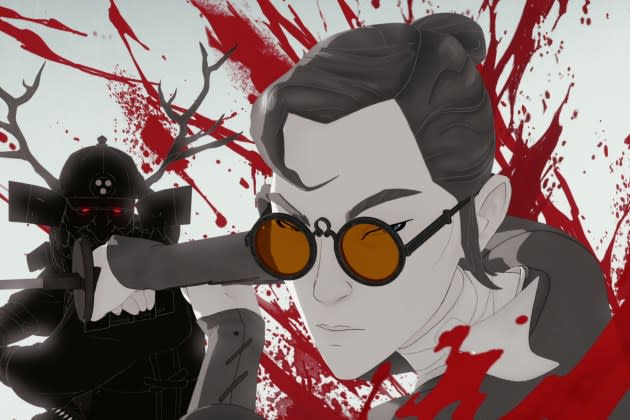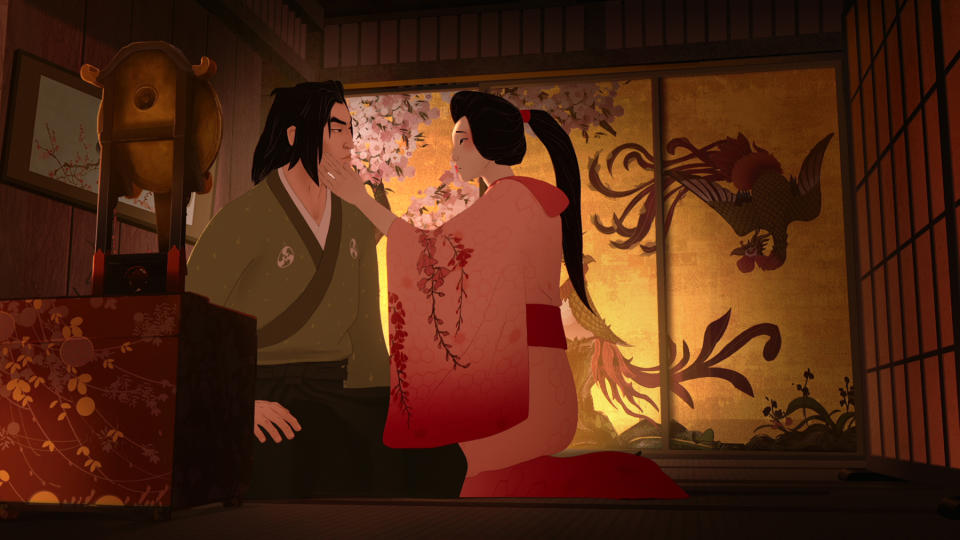‘Blue Eye Samurai’ Is a Gory and Gorgeous Animated Series From Netflix
- Oops!Something went wrong.Please try again later.
- Oops!Something went wrong.Please try again later.

The samurai Mizu stands backed up to the edge of a seaside cliff, flanked by four master swordsman known as the Four Fangs. It is seemingly a no-win scenario for the title character of Netflix’s Blue Eye Samurai. But for eight riveting minutes, Mizu turns this dangerous terrain into an advantage, defying the laws of physics multiple times while carving the Fangs up into little pieces. The closing shot of the sequence may as well be a painting, with the final death blow being delivered while a massive wave crashes in the background, the light of the sun at this hour casting the water in a red glow that makes it look like the combat is taking place on the lip of an active volcano.
For most other martial arts sagas, this would be the jaw-dropping climax of the entire story. For Blue Eye Samurai, it’s barely even a warm-up act for all the gorgeous, gory mayhem to follow.
More from Rolling Stone
'Escaping Twin Flames': How to Break Up With an Online Dating Cult
How David Fincher Turned 'The Killer' Into a Mean, Lean Punch to the Gut
New 'Stranger Things' Play Tells the Origin of the Upside Down
The adult animated drama, whose eight-episode first season debuted last week on Netflix, was created by Logan screenwriter Michael Green and his wife Amber Noizumi. The setting is Japan in the Edo period of the 1600s, when the borders were closed to the outside world, and white people were banished entirely. Our hero is trying to hide two secrets, one more successfully than the other. The better-kept secret is that Mizu, played by Pen15 star Maya Erskine, is a woman disguised as a man. The more obvious one, given those titular peepers, is that Mizu had a white father, rendering her an impure monster to her countrymen. She has concealed her gender and mastered swordmaking and various deadly styles of combat, all so she can seek out the four white men who might be her father, and kill all of them in response to the life of misery she was born into.
Noizumi, whose mixed-race heritage inspired the story, has described the show as “Kill Bill meets Yentl.” Though it leans much closer to Tarantino than Streisand, Blue Eye Samurai deftly counterbalances the elaborately choreographed violence (spearheaded by director Jane Wu and her team) with moments of pure beauty, deep longing, and even amusing gentleness.
The latter quality comes courtesy of Mizu’s disabled would-be apprentice Ringo (played in warmly appealing fashion by Heroes alum Masi Oka), who has learned to navigate life despite his lumbering size and lack of hands. Mizu has no interest in a sidekick, but Ringo gradually wears her down, as if he’s a peaceful stream flowing against a rock over hundreds of years. That dynamic becomes as appealing in its own way as seeing the many, many inventive ways that the series finds for Mizu to kill her many enemies. The show understands this too, which is why Mizu’s battle with the Fangs is intercut with a sequence where Ringo joins in on a local celebration where dozens of seaside villagers leap nude into the water to wish for good fortune in the future.
There is, in fact, a lot of naked flesh on display throughout the season. The series can be just as graphic in depicting sex as it is at violence, yet both avoid feeling gratuitous. One of the more prominent subplots revolves around Akemi (Brenda Song), a princess who is just as eager to escape the bonds of Edo society as Mizu is, but who uses very different methods to achieve that. As she travels in pursuit of her lover Taigen (Darren Barnet) — who in turn is chasing after Mizu to collect a debt of honor — she gets an intimate tour of area brothels, which serve to deepen our understanding of her rather than to simply titillate.
It’s a sprawling world with an impressive cast. Green has written all three of Kenneth Branagh’s recent Hercule Poirot movies, and gets Branagh to play the season’s big bad, a despicable, indomitable arms dealer named Fowler. Randall Park is Heiji Shindo, a crime boss allied with Fowler, the great Cary-Hiroyuki Tagawa is the blind swordmaker who trains Mizu, Ming-Na Wen is a madam who both teaches and learns from Akemi, and George Takei is Akemi’s mentor and protector, among many others.

It’s hard to overstate just how stunning Blue Samurai is to look at. The series uses a mix of 2D and 3D animation styles to create landscapes and characters who seem only a few degrees removed from live-action, even as the form allows for combat on a scale that would cost several large fortunes to craft with flesh-and-blood actors. At various points in the season, Mizu fights solo against an army of gangsters, has to defeat multiple bosses on each level of Fowler’s impregnable fortress home, and fend off an attempted coup of Japan itself. Even without dialogue or characterization, it would be completely engrossing.
Fortunately, though, Green and Noizumi are as interested in the people at the center of these crazy fights as they are in the many improbable techniques Mizu uses against her opponents. Mizu is presented throughout as both supernatural and deeply human. She can handle any odds, and come back from every injury that would cripple or kill a normal person. But the series never loses sight of what a life wholly devoted to revenge has cost her, and the ways in which she has turned herself into every bit the monster that her countrymen believe her to be.
The whole thing is an incredible, utterly badass example of how animation can be used to create worlds, characters, and adventure every bit as vivid as live-action, if not more at times. Choose your weapon and leap right in.
All eight episodes of Blue Eye Samurai are now streaming on Netflix.
Best of Rolling Stone

